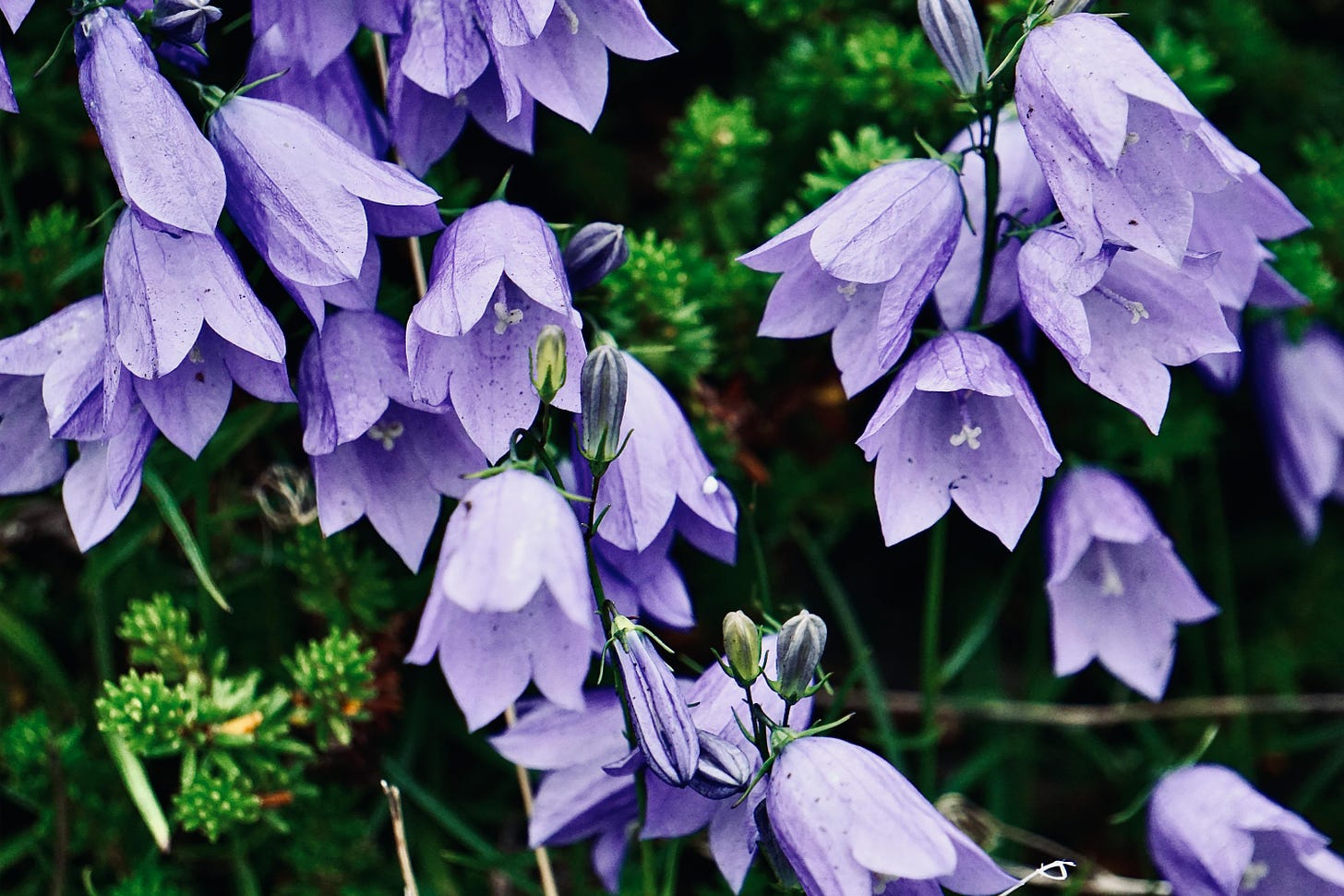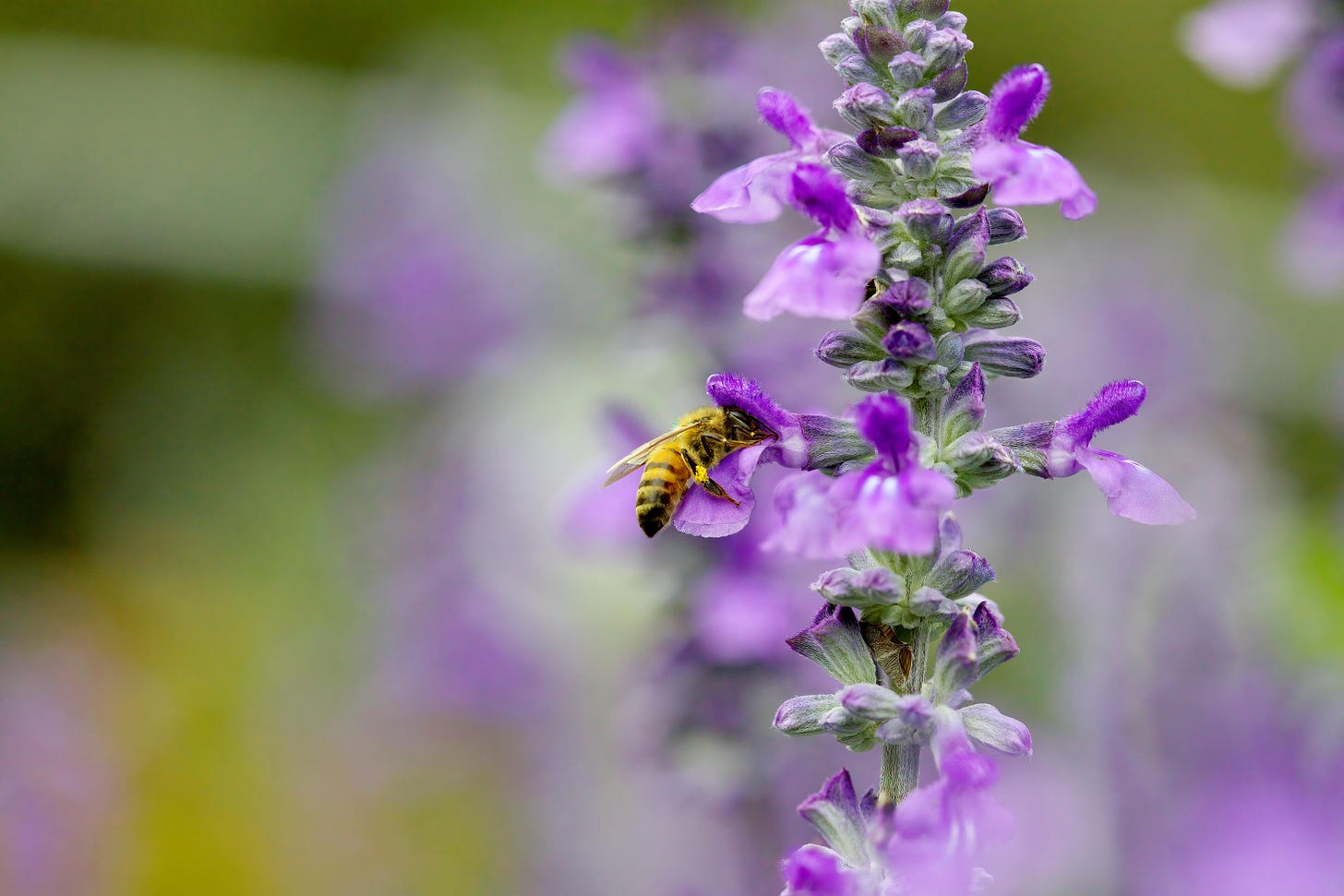Hoverflies and bees are bouncing flower to flower in the garden, which in the past few years has taken a wild format. Bellflowers and woodland sage have transplanted themselves from somewhere in my neighbourhood. I like it this way. Years ago, I spent a few hundred dollars trying to plant a proper garden only to discover that, in my inexperience, I had planted a bona fide salad for the deer and elk that wander our streets. Its humbling, learning something new, but I find joy in the quest for understanding.
The first step is often to figure out which questions I need to be asking to begin with. Which plants will thrive in a mountain garden — at an elevation of 4,537 feet — under the shade of a silver birch?
It turns out, it was best to just let the garden figure itself out. Underneath the yarrow and creeping bellflowers you’ll find coral bells and one surviving hosta — my wee reminders that my experiment wasn’t totally in vain, but Nature certainly knew best.

Today I am writing from my front porch overlooking this wild garden. A late afternoon sun is shining through the trees, illuminating the fluttering birch leaves from behind. Shadow and light tango across my body, which is feeling just right in a light summer breeze. The flowers, with their long stems, dance in the breeze, too.
Days like this are fleeting. Already, our night are growing colder as we move towards September. Come February, likely sooner, I’ll be longing for these summer days again when I can sit outside, in my happiest of places, and do my happiest of things: write. But, like my garden, which will soon succumb to the cold, in just a few weeks I’ll be hibernating again. Seasons and change… we all know that story. But today my wild garden holds another lesson for me.
I watch the bees drawing nectar from the purple sage flowers. I like to think perhaps this means this garden is a happy and healthy place. I like to think that, if we leave things alone, some law of nature will dictate that things will turn out exactly the way they are meant to. I’ve written many times on FIELD NOTES that life feels like this continuous journey of figuring out what the next right thing is; that we’re meant to evolve and reinvent ourselves, to shed the things that are no longer working for us.
But what about working with a blank slate — as blank as a garden bed, full of soil and promise?
Perhaps there are times where we’ve done all that we can; we’ve been manifesting like it’s our last chance, experimenting with new ideas, and creating, creating, creating. (This might look like publishing two books and producing a mid-length documentary film in the span of three years.) 😏 I have no shortage of ideas. Most recently I threw some seeds into the wind in the form of a new book project. But for the next few months, what might it look like to let the garden plant itself?
To try easier.

A year ago I wrote about resisting the urge to run from impermanence: “My instinct is to run, usually into a project — anything to distract me from the feeling that I’m not doing enough.” My temptation is to do something else while I’m waiting to see what grows — to feel (shuddering at the word) productive. But, taking inspiration from my wild garden, productivity can look like doing less and being ready when the ideas begin to bloom. No doubt, I’ll be more surprised and delighted by what begins to grow.
As I sit here, I have my curated writing playlist — a collection of classical and instrumental songs — playing in my ears (tune in on Spotify). The breeze is still kissing my skin in the way only a warm summer breeze can. The sun is lower, but still shimmering. The music is so beautiful, it takes my breath away. I could easily sit here and just… listen. Do nothing. I would be getting just as much out of life in absorbing and receiving as I do producing.
And so, that’s what I intend to do these next few months. Wait patiently to see what grows in my life. Take time for rest and reflection. I’ll know when it’s time to get moving again. I’ll smell the sage and the fragrant bellflowers. I’ll feel the impulse to dig into the Earth, to get dirt under my fingernails. I’ll be drawn to the keyboard once more, to the deep work of creativity, and grow something both beautiful and true.
Meghan J. Ward is an outdoor, travel and adventure writer based in Banff, Canada, a Fellow of the Royal Canadian Geographical Society, and the author of Lights to Guide Me Home. Meghan has written several books, as well as produced content for films, anthologies, blogs and some of North America’s top outdoor, fitness and adventure publications.
Ready to dive deeper with me? Upgrade to a paid subscription.
What’s caught my attention lately… ✨
All the Light We Cannot See (TV mini series) — I have not read the book, an apparent masterpiece from author Anthony Doerr. The TV mini series (I watched on Netflix) showcases phenomenal acting, cinematography, and special effects, as well as a thoughtfully created sense of place. This is the kind of television that makes me wonder why I ever waste time on media that feels cliched and reaching for the low-hanging fruit. This is a delightful and touching story, even with all its sadness.
I contributed to the anthology, Stories from the Trail: Field Notes on Moving Through the Wild, published by
, alongside a lovely line-up of writers. My essay follows similar themes to what’s in this edition of FIELD NOTES. You can find a copy here.
Check these out too… 🙌
Lights to Guide Me Home - my memoir (reviews welcome on Amazon and Goodreads)
The Wonders That I Find - my children’s book
My Email Newsletter - updates about my books, projects, and 1:1 coaching
I am an eight-generation Canadian and a descendent of British, Scottish and German settlers living, working, and recreating outdoors in Treaty 7 Territory — the homelands and gathering place for the Niitsitapi from the Blackfoot Confederacy, including the Siksika, Kainai, and Piikani First Nations; the Îyârhe Nakoda of the Chiniki, Bearspaw, and Goodstoney First Nations; the Tsuut’ina First Nation; the homeland of the Métis and Otipemisiwak Métis Government of the Métis Nation of Alberta, and many others. I am doing my utmost, both personally and professionally, to deepen my understanding of the history of Indigenous peoples and the impacts of colonialism — past and present.




